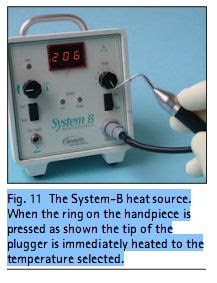Heated gutta-percha has been shown to flow extremely well into all canal irregularities. It is particularly useful in situations such as internal resorption, C-shaped canals, and those with fins or webs. As referred to earlier, when the smear layer is removed the gutta-percha has been shown to penetrate dentine tubules.
This technique is now considered the gold standard for endodontic obturation. The principle of vertical compaction of increments of warm gutta-percha was first described by Schilder in 1967.
Although delivering excellent results, the method was difficult to master and time-consuming.
The state of the art at present is the method first described by Buchanan employing the System-B heat source (Fig. 11), which delivers a precise heat to the tip of the plugger.
A nonstandardised (4%, 6% or feathered tip) guttapercha cone is carefully fitted to the canal. Using a selected plugger, a continuous wave of heat is applied to soften and downpack a cone, resulting in very well-compacted obturation of the apical portion of the canal. The remainder of the canal may be obturated by further increments, or by another method. Briefly, the technique is as follows.
1. Fit a gutta-percha cone and mark it at working length.
2. Select one of the System-B pluggers that binds in the canal 5 7 mm short of the working length. Set a rubber stop at this level, and select a conventional plugger to fit at this length as well.
3. Dry the canal with paper points. 4. Apply a thin layer of sealer to the apical
third of the selected cone, and insert it to working length.
5. Set the temperature of the System-B at 200 C, with full power. Heat is applied to the plugger via the finger-tip microswitch, and the part of the cone extruding from the canal orifice is seared off.
6. The tip of the plugger is placed in the centre of the gutta-percha cone, heat applied, and the plugger is carefully pushed down the canal in one slow, even movement to the depth marked. This should take about 3 seconds. The heat is turned off, and the plugger held in place for a further 10 seconds.
7. With a brief burst of heat to separate the plugger from the gutta-percha, the plugger is removed from the canal. It is usually found to bring with it the coronal portion of the gutta-percha as well.
8. The apical part may now be further compacted with conventional hand pluggers.
9. The coronal part of the canal may now be obturated with either injectable guttapercha, described later, or further use of the System-B as follows.
10. A small length of gutta-percha, about 7 mm, is cut from a further accessory point, coated with sealer and inserted into the canal.
11. With the heat source turned down to 100 C, otherwise this gutta-percha will not stay in the canal, a short burst of heat is applied, the gutta-percha compacted, and the plugger removed as before. Hand pluggers may be used to further compact this and any subsequent increments required.
12. A layer of resin-modified glass-ionomer cement is applied over the obturation, and a post-operative radiograph is exposed as normal.
Although delivering excellent results, the method was difficult to master and time-consuming.
The state of the art at present is the method first described by Buchanan employing the System-B heat source (Fig. 11), which delivers a precise heat to the tip of the plugger.
A nonstandardised (4%, 6% or feathered tip) guttapercha cone is carefully fitted to the canal. Using a selected plugger, a continuous wave of heat is applied to soften and downpack a cone, resulting in very well-compacted obturation of the apical portion of the canal. The remainder of the canal may be obturated by further increments, or by another method. Briefly, the technique is as follows.
1. Fit a gutta-percha cone and mark it at working length.
2. Select one of the System-B pluggers that binds in the canal 5 7 mm short of the working length. Set a rubber stop at this level, and select a conventional plugger to fit at this length as well.
3. Dry the canal with paper points. 4. Apply a thin layer of sealer to the apical
third of the selected cone, and insert it to working length.
5. Set the temperature of the System-B at 200 C, with full power. Heat is applied to the plugger via the finger-tip microswitch, and the part of the cone extruding from the canal orifice is seared off.
6. The tip of the plugger is placed in the centre of the gutta-percha cone, heat applied, and the plugger is carefully pushed down the canal in one slow, even movement to the depth marked. This should take about 3 seconds. The heat is turned off, and the plugger held in place for a further 10 seconds.
7. With a brief burst of heat to separate the plugger from the gutta-percha, the plugger is removed from the canal. It is usually found to bring with it the coronal portion of the gutta-percha as well.
8. The apical part may now be further compacted with conventional hand pluggers.
9. The coronal part of the canal may now be obturated with either injectable guttapercha, described later, or further use of the System-B as follows.
10. A small length of gutta-percha, about 7 mm, is cut from a further accessory point, coated with sealer and inserted into the canal.
11. With the heat source turned down to 100 C, otherwise this gutta-percha will not stay in the canal, a short burst of heat is applied, the gutta-percha compacted, and the plugger removed as before. Hand pluggers may be used to further compact this and any subsequent increments required.
12. A layer of resin-modified glass-ionomer cement is applied over the obturation, and a post-operative radiograph is exposed as normal.
